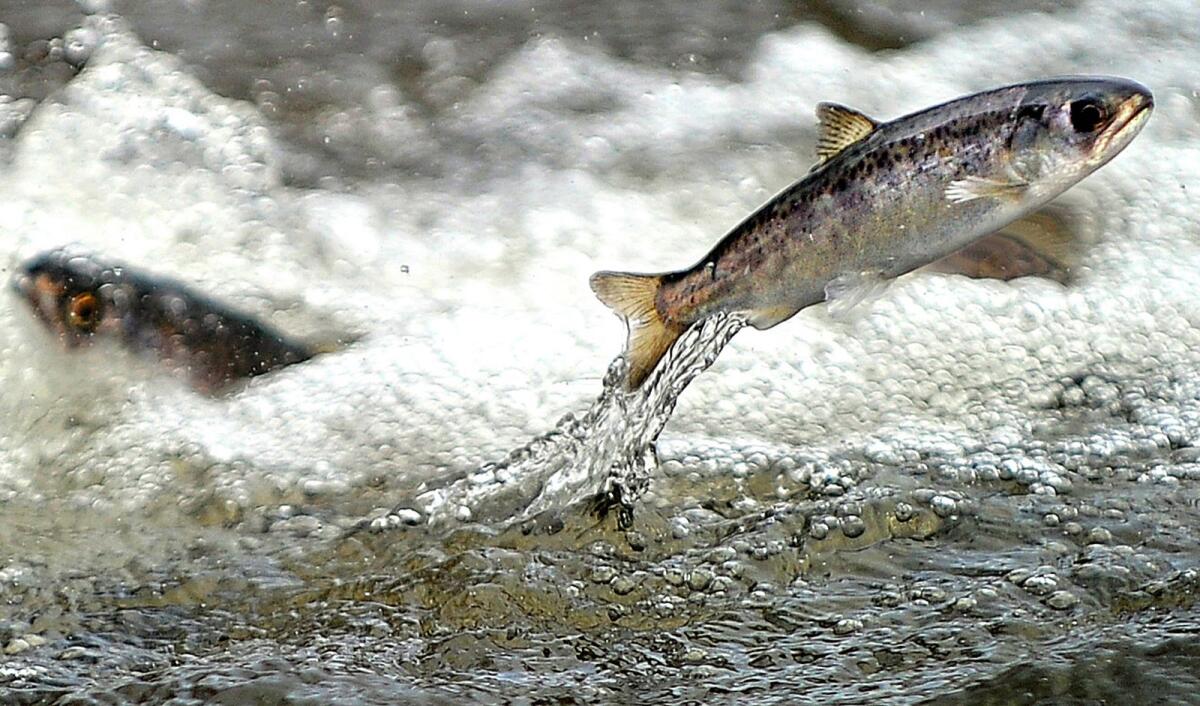Editorial: The California salmon wipeout is even worse than you think

- Share via
The news reports about the California salmon wipeout got a good chunk of the story right: Record-breaking heat waves made Northern California rivers too warm to sustain migrating chinook salmon, and virtually all of the salmon in the Sacramento River this summer have died, or will die, before reproducing. Any eggs that were successfully laid, or the fry hatched from those eggs, are also probably doomed. So a generation of the rare and endangered winter-run Chinook is virtually gone, and the spring-run as well.
Some of the details were a bit off, though. It’s important to know that the salmon are facing extinction not just because of warm weather or climate change, but because of Trump-era policies that continue to be carried out by President Biden’s and Gov. Gavin Newsom’s administrations, despite those Democrats’ professed rejection of Donald Trump’s destructive approach to California’s water. Those decisions are still reversible. It’s very late to save one of the remaining marvels that make California what it is. But it’s not too late.
Salmon are cold-water fish, evolved to begin their lives in bracingly frigid spring water and snow-fed streambeds, then migrate downriver to the Pacific — and then fight their way back again to the locations of their birth to spawn and begin the cycle anew.
California is unique in having four separate annual pulses of anadromous (migrating from saltwater to freshwater) salmon in a single river. Each pulse, or run, is defined by the time of year in which the ocean-going adult fish stop eating and make their way from the Pacific and enter river mouths and estuaries to begin the journey hundreds of miles upstream, against river and stream currents, to spawn — hence the winter, spring, fall and late-fall runs. Although all are chinook salmon, each population is genetically, behaviorally and ecologically distinct and is made up of unique evolutionary lineages that found particular migration times and behaviors for reaching particular spawning pools. It is as if each subspecies mapped out its own travel schedule and chose its own lane in order to leave each other enough space to travel the same highway.
For thousands of years, the winter run’s destinations after traveling from the open Pacific were springs and small pools of water in the Cascades. But that all changed in the 1930s, when construction began on Shasta Dam, owned by the U.S. Bureau of Reclamation. The fish now lay their eggs farther downriver, below the dam, where the water often gets too warm.
One of the bureau’s duties is to keep enough water in the reservoir’s lower depths, where it is shielded from the summer heat, so that it can be released into the river as needed to keep it cold enough to prevent extinction of the winter run. Government biologists issue guidelines prescribing the amount of water needed.
As president, Trump scoffed at those practices, saying all the stored water should go to orchards and farm fields. To use water to prevent extinction, he said, was just “shoving it out to sea.” His Interior Department pushed aside its biologists and got new ones, who issued new guidelines calling for much less cold-water storage.
The Biden administration is adhering to the same weakened and scientifically suspect biological opinions. This year, to its discredit, the California Water Quality Control Board, made up of gubernatorial appointees, signed on to the low storage requirements for cold water in Shasta and the release of water to almond orchards and rice fields. Their plan in effect anticipates the extinction of the winter-run chinook, because the fish have on average a three-year lifespan — and their numbers were decimated last year too, like this year’s wiped-out generation, by water that was too warm and too scarce. It was the failure to retain and release cold water for the winter run, at least as much as record-shattering heat waves, that did in the fish.
After the winter run is lost forever, the spring run is likely next in line, and then the fall run, and the late-fall run, and then that’s it.
Is it a big deal? For people who see salmon as simply a pinkish-orange fish on a plate, perhaps not. Restaurant menus and grocery store freezer cases are full of a distant relative of the chinook — farmed Atlantic salmon, raised in Chile (in the Pacific, ironically) and threatening the local environment.
But saying California can lose the wondrous migrating chinook, a keystone species that for eons has enriched the soil of inland regions and sustained an ecological web that includes black bears in the Sierra and orcas in the Pacific, because there is still a pink fish called by the same name, is a little like saying it would be no big deal to lose the redwoods or the giant sequoia, because after all, there are other trees in other places.
Perhaps we can give up the Western monarch butterfly — also an endemic California migratory species, and also, like the winter-run chinook, down to its last few thousand or so individuals — because there are other butterflies in other states. Perhaps we can lose everything that makes California’s natural environment special.
Whether we do may be up to Biden and Newsom, on whose watch one of California’s most iconic species may be snuffed out because they chose to follow the fake “science” dreamed up in the Trump era. It’s all Californians’ watch too, and after the iconic salmon, butterflies and trees, it may be all of us in danger of being wiped out.
More to Read
A cure for the common opinion
Get thought-provoking perspectives with our weekly newsletter.
You may occasionally receive promotional content from the Los Angeles Times.










